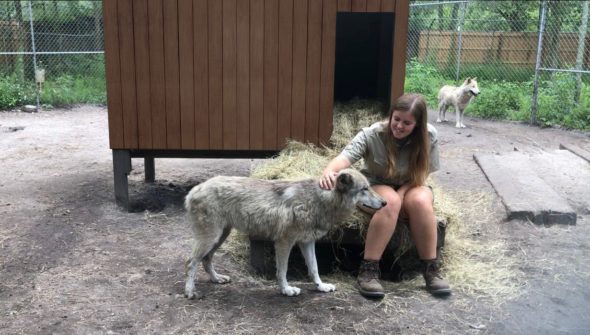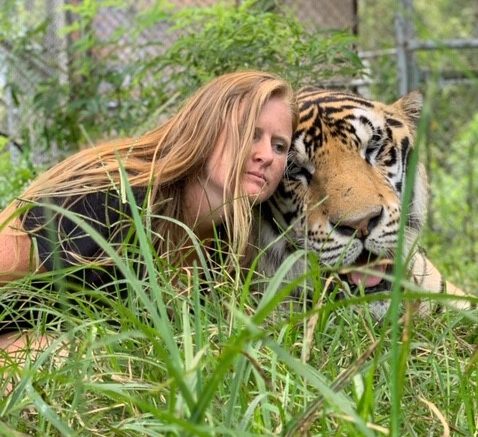By Abigail Haynes
Soon after moving into a new house with her husband, Lindsay Ehrlich began hearing wolves howl, lions roar and hyenas whoop. Within a week of living there, she reached out to the owner of the St. Augustine Wild Reserve in hopes of volunteering to care for these animals. For more than four years, Ehrlich has volunteered at the St. Augustine Wild Reserve caring for various kinds of wild animals.

The St. Augustine Wild Reserve is a home for unwanted and abused exotic animals, according to its website. The reserve is home to many types of exotic animals including wolves, tigers, jaguars, leopards, lions and hyenas.
Ehrlich worked in the restaurant industry for 20 years, but her real dream was always to work with animals. She began volunteering at the reserve one day a week, until she had the opportunity to leave her restaurant job to volunteer at the reserve at least five days each week.
“I was blown away by how well the animals were cared for by the owner and volunteers. It was also evident that the animals adored the humans that cared for them,” Ehrlich said.

Creating a place for these animals to live happily and comfortably requires a staff of dedicated volunteers. Volunteers are split into five levels with varying responsibilities within the reserve to ensure a clean and safe environment for the animals that call it home.
New volunteers start out in level one, with typical responsibilities of cleaning and maintenance duties. These duties include yard work, dishes and cleaning refrigerators. Level one volunteers are trained on diet preparation for carnivores, omnivores and herbivores.
“New volunteers are given these tasks not only because they are vital to the success of the reserve, but also to determine the work ethic, thoroughness and reliability of our new volunteers,” Ehrlich said.
Level two volunteers begin to work with animals when accompanied by a senior volunteer. They can expect to hold hoses, clean den boxes and detail water pails. These volunteers do not have any direct contact with the animals.
Level three volunteers have permission from the owner, Deborah Warrick, to touch the animals.
“This decision is based on the new volunteer’s work habits, common sense and ability to follow safety guidelines and instructions,” Ehrlich said.

Senior volunteers oversee habitat maintenance and perform safety checks in each enclosure throughout the day.
“Lastly, primary handlers are chosen by the owner. Primary handlers are responsible for bottle feeding, clicker training, leash training and are assigned to a new arrival to get that animal acclimated to its unfamiliar surroundings,” Ehrlich said.
Many of these animals arrived at the reserve after they were seized by government agencies from owners that were unlicensed and owned wild animals illegally. The reserve is a rescue home for these animals.
“In some cases, the animals were not cared for properly and came to us frightened, injured, malnourished or obese. We also have retired movie stars and former photo-op animals. The St. Augustine Wild Reserve is a rescue and all of our animals were in need of a forever home,” Ehrlich said.
The St. Augustine Wild Reserve’s mission is to educate the public about the risks and consequences of owning wild animals as “pets.” The reserve offers guided tours weekly to the public.
“During the one-and-a-half-hour guided tour, our guests will hear each animal’s individual story. This includes how the animal came to us, their individual, as well as stories about each animal’s personality and temperament,” Ehrlich said.
Most of the reserve’s tours are “feeding tours,” meaning guests get a firsthand view into a wild animal’s feeding habits and temperament. Additionally, guests can see how animals react with “enrichment items” like large ice cubes, bubble baths, balls and boxes for them to play with.

Ehrlich cherishes the bond she has created with each animal at the rescue. Even on the tougher days, she loves volunteering at the reserve. Some people have assumed that the reserve is an attraction, but this is not the case. The organization is a rescue, and Ehrlich is just one of many volunteers at the reserve educating the general public about wild animals and the work that goes into taking care of these rescued animals.
“I know that everything I am doing, I am doing for those animals and for an owner that genuinely cares for her beautiful animals,” Ehrlich said.
The St. Augustine Wild Reserve is located at 5190 Farm Creek Road in St. Augustine.



Be the first to comment on "A look inside the St. Augustine Wild Reserve"